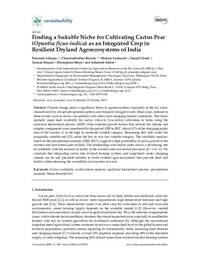Finding a Suitable Niche for Cultivating Cactus Pear (Opuntia ficus‐indica) as an Integrated Crop in Resilient Dryland Agroecosystems of India

Authors:
Climate change poses a significant threat to agroecosystems, especially in the dry areas,
characterized by abrupt precipitation pattern and frequent drought events. Ideal crops, tolerant to
these events, such as cactus, can perform well under such changing climatic conditions. This study
spatially maps land suitability for cactus (Opuntia ficus‐indica) cultivation in India using the
analytical hierarchical process (AHP). Nine essential growth factors that include the climate and
edaphic components were considered for the period 2000 to 2007. About 32% of the total geographic
area of the country is in the high to moderate suitable category. Remaining 46% falls under the
marginally suitable and 22% under the low to very low suitable category. The suitability analysis,
based on the precipitation anomaly (2008–2017), suggests a high probability of cactus growth in the
western and east‐central part of India. The relationship with aridity index shows a decreasing rate
of suitability with the increase of aridity in the western and east‐central provinces (β~−1 to −2). We
conclude that integrating cactus into dryland farming systems and rangelands under changing
climate can be one plausible solution to build resilient agro‐ecosystems that provide food and
fodder while enhancing the availability of ecosystem services.
